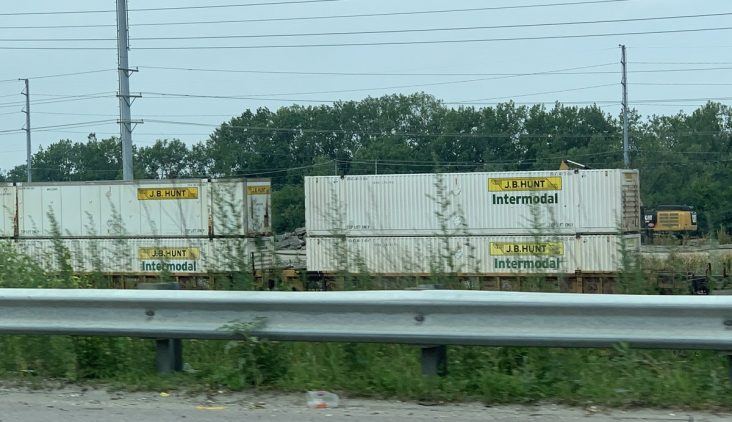Intermodal shippers see emissions, cost benefits, survey shows
by October 23, 2023 1:53 pm 587 views

Most shippers that use intermodal shipping believe it can reduce transportation costs and emissions as they work to meet sustainability goals, according to a recent survey.
Results of the survey were included in a whitepaper by Uber Freight and FreightWaves. The survey comprises shippers from multiple sectors, including the consumer packaged goods (CPG), general manufacturing and retail industries. Nearly two-thirds of respondents said they use intermodal shipping.
Intermodal is a key business segment for Lowell-based carrier J.B. Hunt Transport Services. Executives recently said it’s gaining market share in intermodal.
The whitepaper highlighted several intermodal shipping benefits, including cost savings and environmental factors. Overall, the transportation sector is the largest greenhouse gas emitter, accounting for nearly one-third of U.S. emissions. In the United States, trucks handle about 70% of freight shipments annually, and freight rail accounts for about 40% of long-distance ton-miles.
Rail comprises 2% of transportation’s greenhouse gas emissions and is about three to four times more fuel efficient than truckload, the whitepaper shows.
Between 1901 and 2016, the average global temperature has risen by 1.8 degrees Fahrenheit, according to the National Climate Assessment. Carbon emissions directly contribute to rising global temperatures, and according to the whitepaper, carbon dioxide is the main greenhouse gas, trapping heat in the atmosphere and contributing to global warming.
However, companies are taking steps to reduce their emissions. More than 75% of respondents that spend over $101 million annually on shipping have sustainability goals or public commitments regarding freight transportation. Only 3% of the respondents have neither.
The top three metrics respondents use to track their sustainability goals include carbon emissions per year (56%), fuel consumption (46%) and carbon emission per load (33%).
Almost 60% of respondents who use intermodal agree that it has sustainability and cost benefits compared to traditional truckload. Among respondents who don’t use intermodal, 31% agree it’s a more sustainable and cost-effective shipping option compared to truckload.
The top three factors respondents consider in selecting between intermodal and truckload shipping include cost, on-time delivery and transit time. Respondents ranked emissions the lowest.
Respondents also don’t expect emissions-based regulations to affect their plans to use intermodal. The whitepaper noted regulations such as California’s Advanced Clean Trucks or the U.S. Securities and Exchange Commission’s proposed climate disclosure rule. The previous would require the phase-out of traditional truck sales by 2036 and a path to 100% zero-emissions vehicles on the roads by 2045. The latter would require U.S. publicly traded companies to disclose climate-related information such as greenhouse gas emissions, risks, and impacts on business, and climate goals and plans.
Survey results show that 61% of respondents said these new emissions-based regulations would not impact their intermodal use plans. Still, shippers are more likely to use intermodal than electric or autonomous vehicles.
According to the results, 5%, 13% and 48% of respondents currently use autonomous vehicles, electric vehicles and intermodal, respectively. Those considering today to use them are 16%, 27% and 18%, respectively. Those not considering but would in the future are 56%, 50% and 26%, respectively. And those not considering and would not in the future are 23%, 10% and 8%, respectively.
Intermodal comprises a significant portion of J.B. Hunt’s business. In the third quarter, its intermodal segment accounted for 53% of operating income and 49% of revenue.
In J.B. Hunt’s quarterly conference call with analysts, executives noted that intermodal is gaining market share. Also, the segment’s volumes were up 1.2% in the third quarter from the same period in 2022.
Darren Field, president of intermodal for J.B. Hunt, said it was the first increase in three quarters. Volumes were down 1% in July but rose 1% in August and 4% in September.
“In September, we had our largest intermodal volume week in our history and were able to meet the strong demand with exceptional service,” Field said. “We believe this is driven by the overall market, but also we believe we are taking market share with our strong service that is outperforming the competition.”
He noted that pricing, however, has been a headwind to margins. Pricing was down in the quarter and has affected margins.
“We believe intermodal presents a strong value proposition to customers with significantly improved rail service at a discount to truck pricing, all while cutting carbon emissions on a load by 60% compared to the truck alternative,” Field said. “As such, we see an enormous amount of freight that we believe should be converted from truck to intermodal.”
